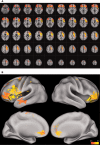Lesion mapping of social problem solving
- PMID: 25070511
- PMCID: PMC4163035
- DOI: 10.1093/brain/awu207
Lesion mapping of social problem solving
Abstract
Accumulating neuroscience evidence indicates that human intelligence is supported by a distributed network of frontal and parietal regions that enable complex, goal-directed behaviour. However, the contributions of this network to social aspects of intellectual function remain to be well characterized. Here, we report a human lesion study (n = 144) that investigates the neural bases of social problem solving (measured by the Everyday Problem Solving Inventory) and examine the degree to which individual differences in performance are predicted by a broad spectrum of psychological variables, including psychometric intelligence (measured by the Wechsler Adult Intelligence Scale), emotional intelligence (measured by the Mayer, Salovey, Caruso Emotional Intelligence Test), and personality traits (measured by the Neuroticism-Extraversion-Openness Personality Inventory). Scores for each variable were obtained, followed by voxel-based lesion-symptom mapping. Stepwise regression analyses revealed that working memory, processing speed, and emotional intelligence predict individual differences in everyday problem solving. A targeted analysis of specific everyday problem solving domains (involving friends, home management, consumerism, work, information management, and family) revealed psychological variables that selectively contribute to each. Lesion mapping results indicated that social problem solving, psychometric intelligence, and emotional intelligence are supported by a shared network of frontal, temporal, and parietal regions, including white matter association tracts that bind these areas into a coordinated system. The results support an integrative framework for understanding social intelligence and make specific recommendations for the application of the Everyday Problem Solving Inventory to the study of social problem solving in health and disease.
Keywords: latent variable modelling; social intelligence; voxel-based lesion–symptom mapping.
© The Author (2014). Published by Oxford University Press on behalf of the Guarantors of Brain. All rights reserved. For Permissions, please email: journals.permissions@oup.com.
Figures



References
-
- Abu-Akel A. A neurobiological mapping of theory of mind. Brain Res Brain Res Rev. 2003;43:29–40. - PubMed
-
- Adolphs R. Cognitive neuroscience of human social behaviour. Nat Rev Neurosci. 2003a;4:165–78. - PubMed
-
- Adolphs R. Investigating the cognitive neuroscience of social behavior. Neuropsychologia. 2003b;41:119–26. - PubMed
-
- Adolphs R, Anderson D. Social and emotional neuroscience. Curr Opin Neurobiol. 2013;23:291–3. - PubMed
Publication types
MeSH terms
Grants and funding
LinkOut - more resources
Full Text Sources
Other Literature Sources

